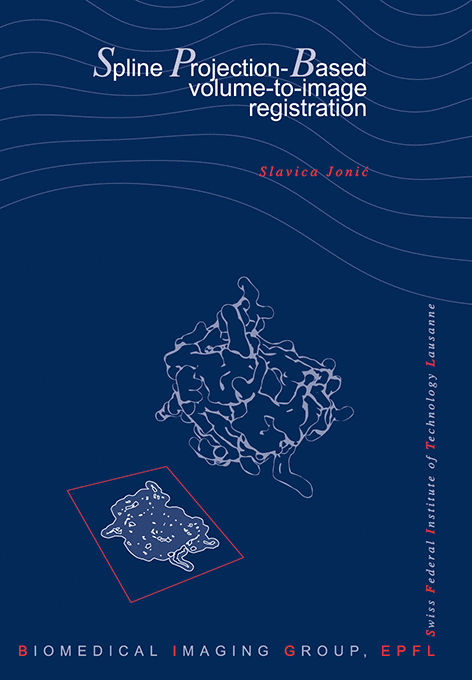Spline Projection-Based Volume-to-Image Registration
S. Jonić
École polytechnique fédérale de Lausanne, EPFL Thesis no. 2901 (2003), 160 p., December 19, 2003.
This thesis focuses on the rigid-body registration of a three-dimensional model of an object to a set of its two-dimensional projections. The main contribution is the development of two registration algorithms that use a continuous model of the volume based on splines, either in the space domain or in the frequency domain. This allows for a well-defined gradient of the dissimilarity measure, which is a necessary condition for efficient and accurate registration.
The first part of the thesis contains a review of the literature on volume-to-image registration. Then, we discuss data interpolation in the space domain and in the frequency domain.
The basic concepts of our registration strategy are given in the second part of the thesis. We present a novel one-step approach for fast ray casting to simulate space-based volume projections. We also discuss the use of the central-slice theorem to simulate frequency-based volume projections. Then, we consider the question of the registration robustness. To improve the robustness of the space-based approach, we apply a multiresolution optimization strategy where spline-based data pyramids are processed in coarse-to-fine fashion, which improves speed as well. To improve the robustness of the frequency-based registration, we apply a coarse-to-fine strategy that involves weights in the frequency domain.
In the third part, we apply our space-based algorithm to computer-assisted orthopedic surgery while adapting it to the perspective projection model. We show that the registration accuracy achieved using the orthopedic data is consistent with the current standards. Then, we apply our frequency-based registration to three-dimensional electron-microscopy application. We show that our algorithm can be used to obtain a refined solution with respect to currently available algorithms. The novelty of our approach is in dealing with a continuous space of geometric parameters, contrary to the standard methods which deal with quantized parameters. We conclude that our continuous parameter space leads to better registration accuracy.
Last, we compare the performance of the frequency-based algorithm with that of the space-based algorithm in the context of electron microscopy. With these data, we observe that frequency-based registration algorithm outperforms the space-based one, which we attribute to the suitability of interpolation in the frequency domain when dealing with strictly space-limited data.

@PHDTHESIS(http://bigwww.epfl.ch/publications/jonic0302.html,
AUTHOR="Joni{\'{c}}, S.",
TITLE="Spline Projection-Based Volume-to-Image Registration",
SCHOOL="{\'{E}}cole polytechnique f{\'{e}}d{\'{e}}rale de {L}ausanne
({EPFL})",
YEAR="2003",
type="{EPFL} Thesis no.\ 2901 (2003), 160 p.",
address="",
month="December 19,",
note="")